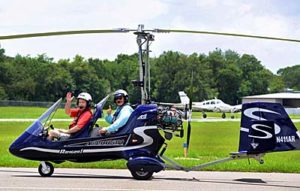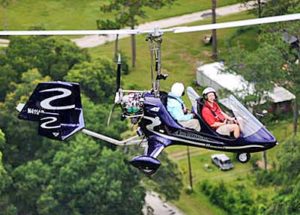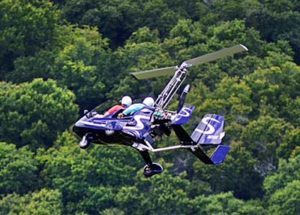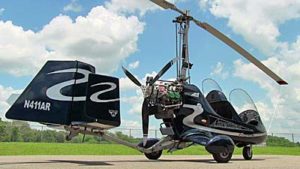
Taxiing out for takeoff with instructor Greg Spicola at the Zephyr Hills, Florida airport. photo by Amy Saunders of Evolution Trikes
Once upon a time… gyrocopters were an American invention. Igor Benson was such an important pioneer that many fixed wing pilots refer to all such flying machines as “Bensen gyros.” Starting in the 1950s, he hit on a good combination of ideas that made the new sector flourish… for a time.
Gyros are small rotary winged aircraft that resemble helicopters in some ways — all have a spinning wing above the occupants. However, gyros work by the air moving across the blades of the rotor disk; their rotors are not powered. Most readers likely don’t need a technical discussion. Suffice it to say gyros and helos are far from the same animal no matter how much they might look like one another.
Yet in the last couple decades things began to change, dramatically. Perhaps to accentuate their differences, modern producers prefer “gyroplanes” while the older Bensen types are often referred to as “gyrocopters.” The old and new are different in important ways.

What’s not to enjoy? The view from a gyroplane like AR1 is enormous. photo by Amy Saunders of Evolution Trikes
Europeans began to modernize older gyrocopter designs. They added solidly mounted tailplanes with greater volume, which greatly stabilized these machines. Igor Bensen’s early gyros had components in the right proportion and the weight in right enough places to make his aircraft work. However, later developers made changes that lacked adequate safety enhancements and the accident rate soared. This fact alone is why many, including some in FAA, think all gyros may be unsafe; that is simply not accurate.
The Euro-style gyroplanes employ tails with larger vertical and horizontal surface area firmly attached to the rest of the carriage. Other factors are also important but the tailplane alone is a major part of why these machines are much more predictable to fly.
The Europeans also continued the development far past adding some stabilizing features. Companies across the Atlantic first partially enclosed the cockpit with half fuselages. They added better seating, instrumentation, controls, and generally improved fit-and-finish. More recently, designers have made fully enclosed models with increasing sophistication in both tandem and side-by-side seating. These improvements uncovered a ripe market.
Rotax Aircraft Engines said that in recent years, they have sold more 912 and 914 engines to the gyroplane sector than any other sector, by far. Germany’s AuroGyro alone has sold more than 2,000 aircraft. Italy’s Magni adds another 900 units while Spain’s ELA has sold 700 units. Other producers account for another 500 making more than 4,000 sales in roughly the same time Americans have bought 3,000 SLSA of all brands.
So what is like to fly a gyro? The simplest comment is that with only a couple exceptions, you fly a gyroplane like a fixed wing. You use the stick and rudders similarly (though not identically). In my third outing — first in a Magni gyro, then an AutoGyro, and now the AR1 — I came away thinking two things. First, my fixed wing skills are highly transferrable to gyroplanes, even better than in a weight shift trike (which I also enjoy). In pursuing a full gyroplane checkout, I would not have to learn many new tricks. Secondly, gyroplanes have some clear advantages.
Something almost everyone notices at airshows is that gyroplanes can fly in winds not advised for many other aircraft. The reason, according to Greg Spicola, my instructor, is that the blades are spinning through the air at something like 400 mph. Therefore, a 25-mph crosswind is relatively insignificant. Combined with a higher wing loading, these aircraft are simply not as vulnerable to winds as most fixed wing aircraft.
Abid Farooqui’s SilverLight Aviation focuses these good qualities with its American Ranger 1 by using an expanded, more effective tail arranged closer to the center of gravity thrust line. Abid explained this provides flight dynamics that reduces coupling between power and yaw and power and pitching. These changes along with a “high inertia rotor system” and a faired fuselage allow AR1 to boast a better glide ratio and energy retention, making landings easier and forgiving even for beginner pilots.
The main cautions I’ve heard for gyroplanes is not jamming the stick full forward (this is ill advised in a fixed wing aircraft, too). Another concern is forgetting that even after you land rather slowly, the rotor may still have quite a bit of spin remaining. If so, it is still making lift and failing to consider that could cause an upset. Likewise, a taildragger landed in a stiff crosswind also demands you handle the controls correctly. Fortunately, control actions that work in an airplane will also work for the gyro. Once the rotor is well spun down, this problem disappears.
I like gyroplane flying and I find plenty of good things to say about them. However, one of the strongest arguments involves price. SilverLight’s AR1 costs only $65,000 with the 100-horsepower Rotax 912 engine. This is a kit, yes, but the build effort is modest and for a modern, comfortable, well-flying aircraft, the price is within reach of most budgets.
Since FAA has never chosen to allow Special (fully built) LSA gyroplanes, kit building is your only option. Unlike several other countries, gyroplanes like AR1 can only be sold in America as an Experimental Amateur Built kit. SilverLight said, “We have decided to offer AR1 as a package where builder assistance is offered to include airworthiness inspection fees plus the first two to three hours of test flight and tuning.” An AR1 buyer travels to Zephyr Hills airport (not far from Tampa, Florida) to SilverLight’s builder assist center for a nominal amount of time. The company added, “Our kit is easy and fast to put together, generally only taking two weeks to be ready for ground testing.” While you put bolt A in hole B, your family can take advantage of Florida’s numerous tourist attractions; it’s not a bad trade and the Z-Hills airport is a fascinating place with all manner of aircraft and a very active skydiving center. C’mon down to Florida and check out the AR1 gyroplane. The view is superlative!
- SILVERLIGHT AVIATION AMERICAN RANGER 1 (AR1)
- Aircraft Configuration — Pusher engine, tricycle gear, tandem seating
- Empty Weight — 628 pounds (912ULS), 650 pounds (914UL)
- Gross Weight — 1,232 pounds
- Minimum Speed (Vmin) — 20 mph
- Maximum Cruise Speed — 105 mph
- Maximum Straight & Level Speed (Vh) — with 914UL: 120 mph
- General Cruise Speed — 55 to 100 mph
- Never Exceed Speed (Vne) — 120 mph
- Takeoff Roll (calm air, turf, pre-rotate to 250 RRPM) — 350 feet
- Landing Roll — 0 to 30 feet with proper technique
- Rate of Climb; sea level, standard conditions — 725 feet/min (912ULS)/850 feet/min (914UL)
- Fuel Capacity — 17 U.S. gallons; welded aluminum
- Rotor — Averso Stella, 27 feet 10 inches (larger rotor system available for high altitude flyers)




The biggest draw back for gyros and helicopters is insurance. You might be able the get the gyro but the insurance takes it out of reach for most. That’s why so many are for sale after a few years; the owners are going broke supporting it.
Presuming you want the Aerolite 103, please contact the manufacturer.
Yes, I want to represent them
what do you think of flying cars? the pal-v is an example
It is an activity we follow but the future of such machines is uncertain at best. We have already reported on PAL-V (use “Search” to see more) and may do so again.
I’m interested in buying a 4 seater kit to offer people tours
Hi James: No one makes an LSA-type gyroplane with four seats.
Dan you do realize the current cost of the PAL V puts it in a whole different Stratosphere than gyroplanes. That’s a vehicle for the 1% to play with vs a gyroplane in which the common man can afford
Hi Paul: Yes, I realize these new concepts are proving to be quite costly, far more than gyroplanes, some choices of which remain relatively affordable. We will observe how things turn out for PAL-V and other such flying machines.